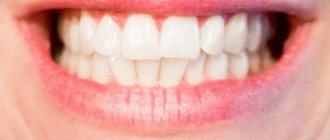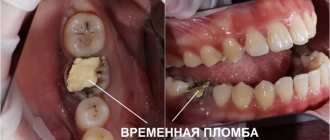Acute toothache is often a consequence of advanced caries and pulpitis. If the nerve is inflamed, the tooth may hurt even in the absence of external irritants: mechanical stress, applying paste, eating cold or hot food. You can relieve pain syndromes with pills, but it is impossible to cure such a disease on your own. If the inflammatory process is started, serious complications of the health of the dental system will arise, which in the future can only be cured with the help of long-term, painful and expensive treatment.
What is a dental nerve
Under the coronal part in the root canals there is soft connective tissue penetrated by nerve endings, capillaries, and lymphatic vessels. It is called the pulp, colloquially the nerve. It performs a plastic, sensory, protective, trophic function.
If inflammatory processes occur and untimely therapy occurs, it may die. If it is impossible to preserve the pulp, amputation is performed. Removing the nerve of a tooth leads to fragility of hard tissues, but with correct treatment it will retain its functionality for many years.
Nutrition after wisdom tooth removal.
IT IS FORBIDDEN:
- Alcohol can cause the death of a blood clot in the socket of an extracted tooth and infection of the wound;
- For the first 2 to 3 days after surgery, it is advisable to exclude solid foods from the diet, for example, fresh carrots and apples. Chewing hard food will cause discomfort and lead to tissue tension in the area of the extracted tooth. As a result, the stitches may come apart and begin to bleed;
- Eliminate cookies, chips, popcorn and crackers from your diet. Firstly, for the reason stated above. Secondly, small solid particles can injure the wound surface and get into the wound;
- The food should not be very hot;
- Eliminate chewing gum from your diet for at least 5 days, as the stitches may come apart during chewing;
- Limit your consumption of caffeine-containing drinks: coffee, energy drinks.
CAN:
- The diet should consist of soft food that does not contain small solid particles that can get into the wound. These are porridge (semolina, oatmeal), mashed potatoes (potato, for example), boiled cereals (rice, couscous, millet, buckwheat);
- Soups and puree soups;
- Vitamin cocktails, freshly squeezed juices and smoothies (except citrus fruits, as they have an irritating effect on the wound);
- In principle, you can eat anything as long as you put the food through a blender to obtain a puree-like consistency.
Indications and contraindications for removal
Pulpitis is treated conservatively and surgically. If it is possible to preserve the pulp, the dentist tries to cure the disease with medications and physiotherapy.
The nerve must be removed in the following cases:
- if the carious lesion has spread to the canals and pulp;
- there is a concomitant disease of periodontitis (inflammation of the periodontium, which holds the tooth unit in the socket);
- severe damage to dentin by caries (large area, presence of several carious cavities);
- mechanical damage;
- the presence of concrements in the canals - hard deposits that cause irritation and inflammation of soft, sensitive tissues;
- lack of positive results from therapy;
- unbearable pain that cannot be relieved by medications.
Depulpation can also be carried out if the orthopedist indicates prosthetics.
The procedure is not performed if:
- stomatitis, acute infections, since pathogenic microorganisms can penetrate deep into the jaw and cause the development of serious diseases;
- poor blood clotting due to the risk of heavy bleeding;
- pregnancy due to the inability to provide the necessary anesthesia.
Contraindications
The dentist will refuse to perform depulpation if:
- history of acute respiratory viral infection, sore throat, influenza;
- Stomatitis, acute leukemia, and hepatitis of infectious origin were diagnosed.
Contraindications to manipulation are heart disease in the acute stage and inflammatory pathologies of the oral cavity.
Remember: women in the 1st and 3rd trimester of pregnancy cannot have the nerve removed! This is due to possible psycho-emotional outbursts and (in the absence of pain relief) the painfulness of the procedure. Anesthesia during these periods is undesirable.
Modern techniques
Until recently, the procedure was very painful and was divided into 2 stages. At the first visit, the canal was expanded with a drill, arsenic was placed into the cavity and a temporary filling was placed. A few days later they carried out cleaning, and only after that the filling began. During the interval between procedures, the patient experienced severe pain, which could not always be relieved with medications. Today, depulpation is done in one visit, and the session time does not exceed 30 - 40 minutes.
If during diagnosis it turns out that the pulp needs to be removed (or its partial extraction is required) or the treatment did not give the desired effect, then the doctor chooses the method that is best suited for the particular case.
During vital amputation, a small part of the nerve that is located under the crown is removed, after which the tooth is filled. Thus, the dental unit continues to receive nutrition, which means it is alive and fully functional.
Devital amputation is done if complete removal of the tooth nerve is necessary. It becomes “dead”, fragile, but can still perform its function for a long time.
Procedure steps:
- anesthesia;
- isolation from saliva getting inside;
- drilling out a carious cavity;
- antiseptic treatment;
- depulpation;
- cleaning, obturation and filling of canals;
- application of a light-curing composite.
The work is very difficult and can only be performed by a professional doctor. If you miss even minimal cavities, lateral tubules, then the dental tissues react and begin to collapse. In our clinic, a panoramic photograph of both jaws is taken, and treatment is carried out under a dental microscope. It allows you to perform dental operations with high precision, protects against injuries, as well as the development of complications and relapses.
Why remove wisdom teeth?
PHOTO: Extracted wisdom tooth. Please note: the roots spread in different directions, thanks to which the tooth is held very firmly in the jaw.
Removal of a wisdom tooth is resorted to in situations where, in the process of its development and eruption, it threatens the health of nearby healthy teeth, adversely affects the development of dental occlusion, or there is not enough space for eruption. When a wisdom tooth does not have enough space in the dentition, it begins to “push” adjacent teeth, which often causes malocclusion and the appearance of crowding of the front teeth in older age. A beautiful smile with evenly spaced teeth can be lost due to loose front teeth.
If infection and inflammation of the gums develop in the retromolar area, pain appears when opening the mouth and eating - it becomes difficult to open the mouth; The submandibular lymph nodes enlarge, body temperature rises. Inflammation of the gum mucosa may decrease and disappear, or an abscess (abscess) may develop, which will require emergency surgery and hospitalization. If a wisdom tooth constantly bothers you, the gum above it hurts (the hood of the mucous membrane), it must be removed.
Incorrect position of the third molar in the dentition is often the cause of the development of caries both on it and on the adjacent tooth. Treatment of wisdom teeth is difficult due to their remote location in the oral cavity and causes patients a lot of discomfort, as they have to sit for a long time with their mouth very wide open.
Advantages of contacting FamilySmile
In our clinic, tooth nerve removal is performed by doctors with extensive experience. We provide dental services of any complexity, including implantation, prosthetics, treatment of baby teeth, teeth with thinned enamel, loose gums with increased sensitivity and much more. We carry out diagnostics and dental treatment under a microscope, which magnifies the image 30 times. The doctor can see all the defects in the root part and eliminate them accurately and painlessly.
We use only safe drugs, high-quality injections and filling materials. At the patient's request, we treat under anesthesia or sedation.
Removal steps
Depulpation is a dental operation that is carried out in stages:
- Examination and diagnosis. Radiography is often used. This research method helps determine the viability of nerve endings, the length and direction of canal branches.
- Anesthesia. Local anesthesia is preferably used, but sometimes general anesthesia is administered for medical reasons or patient preference.
- Isolation of the tooth using a rubber dam (special latex film). This will help prevent infection from entering the open cavity of the canal.
- Depulpation. After removing the destroyed layer of enamel and dentin, the pulp chamber is opened. The contents are removed using a pulp extractor.
- Filling root canals with gutta-percha.
- Installation of temporary or permanent filling.
- Repeated radiography to detect voids in the canal and double-check the accuracy of installation of the filling material.
This depulpation process is applied to premolars and molars, except for the number eight. Removing the nerve in a wisdom tooth is a more complex procedure. The location of the tooth does not always allow for high-quality filling of the canals.
Complications after surgery
The main causes of complications are fatigue, lack of professionalism of the dentist, and poor-quality equipment.
A complication from the aesthetic side is a change in the shade of the tooth crown. Its color depends on the material used to prepare the filling.
Care after removal
It is important to strictly follow the dentist’s recommendations and follow all his instructions:
- absence of stress for 2-3 hours after depulpation;
- It is forbidden to eat food and drink drinks for 4-5 hours;
- It is not recommended to chew on the side where the filled tooth is located for about a few days;
- Be sure to rinse and take medications prescribed by your doctor.











